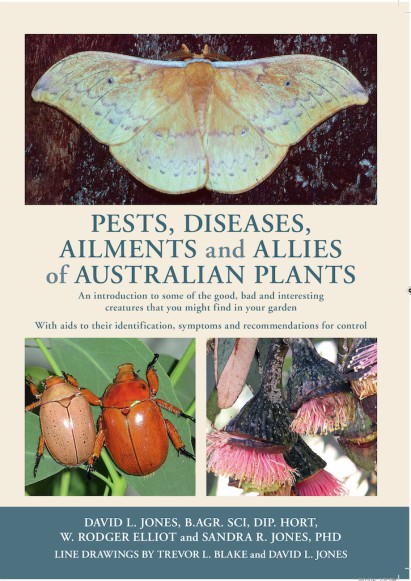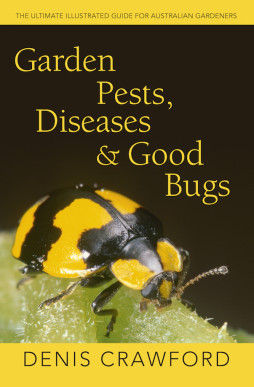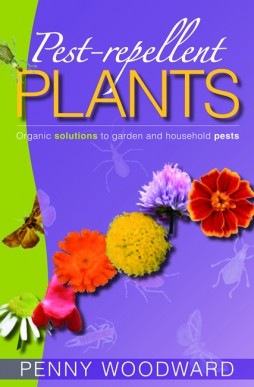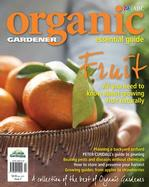 This amazingly comprehensive book is full of beautiful photographs and detailed information about the good and bad bugs and diseases in our gardens. Although focused on Australian plants, many of the insects described are also relevant to exotic species including edible plants. Although chemical and organic approaches to the pests and diseases are given, the authors’ clearly tell us their preferences lie in creating a balanced natural environment, and add that they ‘hope the book assists readers to recognise the wondrous diversity in their gardens.’
This amazingly comprehensive book is full of beautiful photographs and detailed information about the good and bad bugs and diseases in our gardens. Although focused on Australian plants, many of the insects described are also relevant to exotic species including edible plants. Although chemical and organic approaches to the pests and diseases are given, the authors’ clearly tell us their preferences lie in creating a balanced natural environment, and add that they ‘hope the book assists readers to recognise the wondrous diversity in their gardens.’
In the introduction they also point out that most of the insects and small invertebrates that we find in our gardens are harmless to us and our plants. Accurate identification is essential if we are going to be able to deal with pests in the least harmful way. I will be using the book to learn about what is in my garden and about their life cycles and what, if anything, I need to do. At the very least every gardener should make an effort to become familiar with beneficial insects, so that we are not killing them by mistake.
In the Prelude there are useful starting points on the road to identifying a problem. These are a list of Symptoms and Recognition Features of Pests, Photo Short Cuts, and a Pest Control Table. With its depth of scholarship and knowledge, and wonderful accurate photographs, it is cheap at $45
By David Jones, Rodger Elliot and Sandra Jones, Reed New Holland, 2015, paperback with PVC cover, 448 pages, $45
 The ultimate illustrated guide for Australian Gardeners
The ultimate illustrated guide for Australian Gardeners
For me, the best part of this book are the photographs. For someone who wanders around gardens, closely inspecting the insects and other micro fauna, as well as the plants, it is wonderful to have a book that I can turn to in an attempt to identify what I am looking at. The text is excellent too, with careful and clear explanations to aid identification, explain life cycles and suggest controls.The three main sections cover Beneficial organisms, Pests, and Diseases, disorders and deficiencies.
There’s also tables near the beginning that list common pests and diseases by plant group. So if something weird is happening to your tomatoes, under Solanaceous plants you’ll find all the pests and diseases that affect this family. Its a bit disheartening that there 45 altogether for just this one group! But it does help to narrow it down and point you to the page and picture to help you work out what it might be. Highly recommended for anyone who loves to garden and wants to understand the other creatures that live in their garden. Denis Crawford has 35 years of experience with this subject and his expertise shines through in the book.
If you want a copy then pick it up at your local independent bookshop, or borrow it from your library.
by Denis Crawford
PB 464pages, ABC Books, HarperCollins Publishers, ISBN 9780733331886 $39.95

My new book has finally arrived on the bookshelves around Australia. This is the second edition of the book of the same title that sold more than 20,000 copies with three reprints. This edition is completely updated with new information and new photographs. It covers the philosophy of pest-repellent gardening, that the garden should be a haven for all creatures and plants, big and small, not a battle ground. That sprays that kill (even organic ones) should be a last resort. That gardeners need to concentrate on healthy soil and healthy plants, as well as a diversity of planting, including predator attracting plants. We also need to provide homes and food for frogs, birds, lizards and bats, all of which feed on pests. Then the book looks at masking, repelling and killing plants and their numerous uses. As well as other solutions such as traps, trickery, netting and barriers to keep pests away from our precious plants. And common household items that are organic and can also be used against pests: soap, molasses, coffee, bicarbonate of soda, copper, sulphur and even water, to name but a few. The final section looks at the pests.
I encourage you to spend time in your garden, get to know your insects, as not all insects are pests and only spray once you have tried all the other solutions. Ask your local library to get a copy, buy the book from your local bookshop or buy it online in our store. Pest-Repellent Plants
 Organic Gardener Essential Guide: Fruit
Organic Gardener Essential Guide: Fruit
This mook (a cross between a magazine and a book) is the second in the series produced by Organic Gardener Magazine. It is made up of articles by well-known garden writers from across Australia. Some articles have been previously published by Organic Gardener, others are written specifically for this mook. There is everything from pruning (an article I keep going back to, to check how it should be done) by Peter Cundall to pest control by Jerry Coleby-Williams and planning the orchard by Phil Dudman. It also looks at harvesting and storing the produce. The fruits covered include apples, avocado, bananas, berries, citrus, grapes, mangoes, melons, nuts, olives, passionfruit, stone fruit and strawberries. Comprehensive and cheap at only $10.
Borrow a copy from your library, buy one from your local newsagent or go to the store on this website and buy a copy online
 This amazingly comprehensive book is full of beautiful photographs and detailed information about the good and bad bugs and diseases in our gardens. Although focused on Australian plants, many of the insects described are also relevant to exotic species including edible plants. Although chemical and organic approaches to the pests and diseases are given, the authors’ clearly tell us their preferences lie in creating a balanced natural environment, and add that they ‘hope the book assists readers to recognise the wondrous diversity in their gardens.’
This amazingly comprehensive book is full of beautiful photographs and detailed information about the good and bad bugs and diseases in our gardens. Although focused on Australian plants, many of the insects described are also relevant to exotic species including edible plants. Although chemical and organic approaches to the pests and diseases are given, the authors’ clearly tell us their preferences lie in creating a balanced natural environment, and add that they ‘hope the book assists readers to recognise the wondrous diversity in their gardens.’


